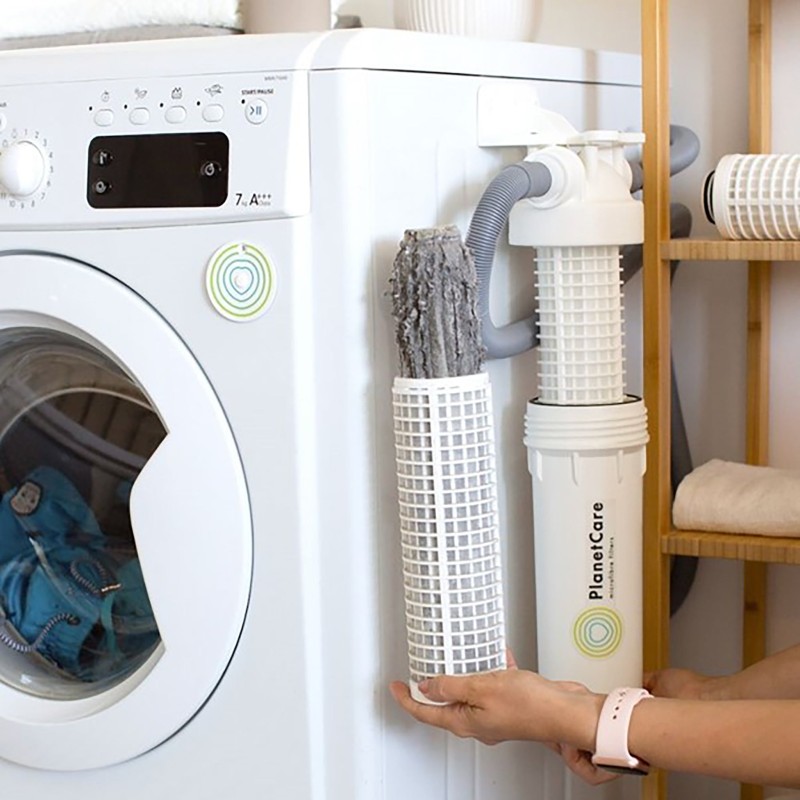
Most of us don’t think twice about what goes down the drain when we put on a wash. Truth is, every laundry load can release thousands of tiny plastic fibres straight into our waterways. These fibres, called microfibres, can travel all the way from our washing machines to rivers and seas.
Now, more people are picking up on microfibre filters for their washing machines. These clever little gadgets trap the fibres before they escape, making it easier than ever to help keep our clothes clean without harming the planet.
If you care about ocean life and want a healthier home, it’s worth looking at why microfibre filters matter and how they offer a simple fix anyone can use.
How Microfibre Filters Cut Pollution
Washing clothes might look harmless, but the fibres that sneak out with each spin can end up almost anywhere. These microfibres, from our synthetic clothes, are so tiny you can’t spot them with the naked eye, but they carry a big problem for our rivers, lakes, and oceans.
Microfibre filters act like a barrier, catching those tiny threads before they’re washed away. Here’s how these simple upgrades make a real difference to the world’s water.
Capture of Synthetic Fibres
A microfibre filter works by sitting on the outflow of your washing machine and using a fine mesh to trap fibres as water leaves the drum. Most synthetic fabrics like polyester and nylon release microfibres that range from 1 to 500 microns across (about the size of fine dust or hairs). For perspective, a single human hair is roughly 70 microns wide.
What makes the mesh of these filters so effective is the tight spacing in the material. The mesh is woven with gaps often smaller than 100 microns, so it easily catches even the smallest synthetic threads. That means most of the harmful fragments stay in the filter and don’t keep flowing through the pipes.
Here’s why this matters:
- Removes invisible plastics: The filter catches fibres too small for most water treatment plants to handle.
- Protects plumbing and septic systems: It stops fibres from building up in household pipes.
- Prevents microplastics from escaping: By catching synthetic fibres at the source, there are fewer chances for plastics to reach waterways where they can last for decades.
In simple terms, installing a microfibre filter keeps those tiny pieces of clothing out of rivers and seas, making every wash a bit gentler on the planet.
Lowering Microplastics in Waterways
The link between synthetic microfibres and microplastic pollution is clear. When they escape into drains, they slip past water treatment and end up floating in streams, lakes, and oceans. These plastics don’t break down easily. Instead, they build up in places where both wildlife and humans can come into contact with them.
A growing body of research backs up the impact of microfibre filters. For example, a 2021 study led by UK scientists found that washing machines fitted with microfibre filters reduced the number of fibres released into wastewater by an average of 78 percent. This sharp drop means fewer plastics end up in rivers and on beaches.
The average washing machine setup releases 700,000 to 1 million microfibres per wash. With a microfibre filter, this is much lower (below 200,000).
By slashing the number of microfibres heading out with each laundry cycle, filters act as a simple step anyone can take to cut plastic waste. Cleaner water isn’t just good news for sea life like fish and turtles. It also benefits anyone living downstream, and anyone who cares about what’s in their drinking water.
A Microfibre Filter with Refillable Cartridges

PlanetCare (use code ENGLANDNATURALLY15 for 15% discount on all orders) is a one-time purchase (you just send back empty cartridges to order new ones. This will ensure that microplastics are caught and recycled, when washing synthetic fabrics in washing machines.
Unless all your clothing is made from cotton, hemp and linen, chances are you have some clothing made with nylon, polyester or recycled plastic bottles (this includes knickers and socks with elastane, and washable nappies, sanitary pads and period pants with waterproof backing).
Nearly all swimsuits are synthetic material. So only rinse when needed, then leave to air-dry.
PlanetCare is different. It fits to your washing machine in 10 minutes, and captures around 98% of microplastics. Once the cartridge is full (around 30 washes),send it off for recycling, and use the new empty one sent back.
Microfiber Filters for Sinks & Buckets

If you hand-wash clothes, sink filters (from another company that also offers bucket filters to catch microplastics from mops with synthetic heads) are one option. Also use plastic-free cloths and sponges (rather than ‘microfiber cloths’ which also leach plastics, when washed).
This company has no return system, so securely bin caught microplastics (in a secure container that won’t wash fibres away at landfill, in rain).
It also offers a service to help hotels and professional laundries find a retrofit filter to fit to washing machines, to avoid microplastic pollution.
Cora Balls (a more budget-friendly option)
If you can’t afford a PlanetCare set, than at least use a Cora Ball (sold in UK). This only collects around 30% of microplastics, but is better than nothing.
Inspired by how corals naturally clean the oceans, this tumbles around the washing machine, collecting fibres. Then just pull them out (like cleaning a hairbrush). This invention is designed to withstand the heat of washer-dryers, and profits are used to help clean the oceans.
Fionn Ferreira is a young Irish chap who has created a magnet to extract microplastics from the ocean.
Protecting Marine Creatures

Cleaner water has a ripple effect across the ocean, helping every living thing from tiny plankton to giant turtles. When we catch microfibres in the wash, we’re not just thinking about beaches and clear water, but also the health of everything that swims, crawls, or soars above the sea.
Fish, plankton, turtles, and birds all lose out when their world is clouded with plastic fibres. Microfibre filters keep these tiny threats out of the water, protecting some of the most vulnerable life in our oceans.
Effect on Small Marine Life
Tiny sea creatures might seem far away, but they’re at the very heart of the ocean’s food web. Take copepods as an example. These small, shrimp-like animals drift through water, eating anything they find—including microfibres. microfibres look a lot like food to them, so they swallow them by mistake.
What happens when copepods and other plankton eat microfibres?
- Health declines: Their stomachs fill with plastic instead of real food, making it hard for them to get the nutrients they need. They may eat less or stop eating altogether.
- Growth slows: Without enough food, these creatures grow more slowly or not at all. This puts their survival at risk.
- Reproduction drops: Sick or weak animals are less likely to have healthy offspring, shrinking their numbers over time.
Since plankton feed bigger animals, trouble at this level affects everything up the food chain. Cleaner water gives plankton and fish larvae a better shot at a healthy life, keeping the foundation of ocean life strong.
Benefits for Bigger Species
The risk climbs as we look higher up the food chain. Larger sea animals, like turtles, dolphins, and seabirds, all depend on smaller prey for food. When fish and plankton are full of microfibres, the pollution passes along to whoever eats them.
Some effects on bigger species include:
- Turtles: Young turtles are especially at risk. They feed in coastal waters, where microplastic levels are highest. Eating prey laced with fibres can block their guts and make them feel full when they are not.
- Seabirds: Birds like puffins or gulls might swallow fish containing microfibres. Over time, the fibres build up in their stomachs, leading to weight loss and poor health.
- Fish: Larger fish, crucial to the food chain and even our own meals, also eat smaller fish or plankton that contain microfibres.
Put simply, fewer fibres in the sea mean safer meals for all these creatures. When we stop the problem at the source with a laundry microfibre filter, it’s not just the smallest sea life that benefits, but the largest too. Healthier animals mean better survival rates, more balanced marine life, and less pollution winding its way back to people.
Next time you set the wash going, remember that what leaves your machine might end up far from home. That little filter in the laundry can help keep both plankton and giant turtles out of trouble, making the whole ocean safer for everyone.
Extending Appliance Life
Laundry microfibre filters do more than just help the environment. They can actually make your washing machine and dryer run better for longer. By trapping loose fibres, these filters take the stress off your appliances.
Think of them as a shield, protecting the moving parts from being choked by lint and fluff. You save on repairs and keep your machines working their best with less fuss.
Less Lint Build‑up in Machines
When you use a microfibre filter, it stops most of the loose fibres before they can settle inside your washing machine. Without a filter, these tiny threads can collect on the drum, rubber seals, pipes, and the pump. Over time, this build-up is like plaque in arteries, blocking the flow and making motors and pumps work harder.
Never leave lint out in gardens, it’s a choking and mould hazard for birds and wildlife. Just securely bin.
Here’s how these filters help:
- Prevent fibre clumps: Filters grab the fibres before they get a chance to latch onto drum walls or get sucked into the pump’s workings.
- Steady performance: Clean machines run without extra strain. This keeps cycles from dragging on or spinning slower than they should.
- Fewer smells and problems: Lint and residue can trap moisture and soap scum. By blocking them, filters help keep your machine fresh inside.
The less lint and fluff inside your machine, the fewer breakdowns you get. That means fewer callouts to repair the pump, unblock drains, or replace worn parts. Over a year, this saving can add up.
Reduced Maintenance for Tumble‑drying
Dryers work best when their lint screens are clean. Every load that leaves fewer fibres behind in the wash means your dryer’s filter stays clearer too. If your washing machine sheds less fluff, your dryer doesn’t have to work as hard.
Let’s look at the main benefits:
- Cleaner lint screens: With fewer loose fibres coming from the wash, your dryer’s lint trap doesn’t gum up as quickly.
- Better airflow: Clean screens keep air moving fast, so your clothes dry evenly and the dryer stays safe from overheating.
- Shorter drying times: Less lint means the dryer doesn’t need to slog through several cycles to get things dry.
Read more on how to dry your clothes, naturally.
The result? Routine cleaning gets easier. You won’t have to scrape matted lint from hidden corners every week. As a bonus, both your machines will likely last longer, and you’ll notice fewer surprise repairs on your yearly budget. With microfibre filters fitted, it’s a simple path to smoother laundry days.
Improving Laundry Quality
Most people buy laundry microfibre filters to help the sea, but there’s another bonus you can’t ignore. These tiny traps mean your wardrobe gets a boost too. When fewer fibres escape in the wash, your clothes come out looking fresher, feeling softer, and lasting longer.
It’s a simple upgrade for your laundry routine that makes a big difference every time you open the machine.
Cleaner Clothes After Wash
Microfibre filters act like a bouncer at the door, stopping loose threads before they can float back onto your favourite top or trousers. Normally, the fibres shed from synthetic fabrics in the wash mix with dirt and detergent.
Without a filter, these stray bits cling to your clothes in the final rinse, making fabrics look dull and dusty.
With a filter installed, here’s what changes:
- Most of the microfibres are trapped and removed.
- Fewer particles stick to your clothes.
- The fabric feels smoother, less gritty, and much cleaner.
Clothes come out not just smelling fresh but actually feeling cleaner. Ever noticed how some jumpers seem to attract fluff and dust straight after washing? With fewer microfibres swirling in the water, your jumpers stay sharp and colours stay bright.
For allergy-prone people, this is even better news since trapped fibres are less likely to cause sniffles or skin itch.
Fewer Stains and Pilling
Those stubborn little spots or funny lumps that crop up on t-shirts and socks? Many start with stray microfibres left behind with every wash. Tiny bits from old polyester threads can cling, build up, and show as faint stains or annoying pilling (those little fuzz balls that make clothes look old before their time).
A microfibre filter changes the picture.
- Synthetic fibres are trapped, not swirled around the drum.
- Stains from leftover residue are less likely to form.
- Fabrics, especially soft cottons and delicate blends, are protected from surface roughness.
When you pull your favourite shirt from the machine, you want it to look as new as the day you bought it. Trapping shed fibres stops them from blending into the fabric weave and causing those unsightly pills. Over time, not only do your clothes stay brighter and neater, but they also keep their shape.
For those who treasure certain jumpers or are tired of buying new school uniforms every year, this is a simple fix that pays off. Expect fewer complaints about scratchy collars or odd grey marks on shirts. With a filter, the life of your wardrobe quietly stretches on, making laundry day that bit more rewarding.
Conclusion
Using a laundry microfibre filter stops a lot of plastic waste from heading into the sea, keeps marine life safer, and helps your appliances last longer. It’s a small step with a big payoff for both your home and the environment.
Adding a filter to your laundry routine is simple, and it’s an easy win for anyone keen to keep clothes looking good while protecting the planet. Give it a try and see the difference for yourself. Tell a friend or share this tip with someone you know—the oceans and your washing machine will thank you.





